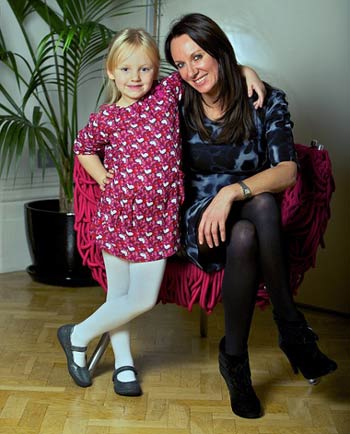|
 Future proofed: Alex Silver and daughter Scarlett. She has banked her daughter's umbilical cord blood in case of any future medical emergencies |
|
Today there are about ten businesses in the UK offering to freeze and store cord blood and industry insiders estimate that up to 100,000 parents have chosen to do so in the UK. The global stem-cell market is forecast to treble to a staggering £40 billion by 2015. Cord blood contains embryonic stem cells. They can be made into more specialised cells and can reproduce copies of themselves almost indefinitely. There is currently research into a host of applications – from growing new organs to curing paraplegia. In theory, stem cells treat disease by replacing damaged or diseased cells. They are used in bone-marrow transplants to treat leukaemia – but in these cases, donor blood taken in the usual way is used to harvest the stem cells. To bank cord stem cells, the cord blood is extracted minutes after the birth of the baby and rushed by courier to be processed. Any cells that could be of future value are frozen at minus 180C and can then be stored for 25 years. There are no published examples of a child’s own cord blood being used to cure them of leukaemia – one of the most common childhood diseases mentioned by the banks in their sales pitches. There are two cases of successful sibling transplants for children with the hereditary condition thalassemia, where the body makes an abnormal form of haemoglobin – the protein in red blood cells that carries oxygen. These were carried out in Singapore and Germany. Lavish promises of future treatments tend to be based on preliminary clinical trials – and should a child fall ill today, in many cases the technology doesn’t exist to actually use the harvested stem cells. In fact, some experts believe that reintroducing banked cord blood into a child could increase the chance of relapse – as disease-causing cells that existed from birth would be stored alongside useful stem cells. ‘Parents are worried that by not storing cord blood, they aren’t giving their child the best possible chance for future health,’ says leading consultant gynaecologist and obstetrician Mr Dickinson Cowan, who admits that when he first came across private banking, he thought it was a good idea. ‘I’d never recommend it now,’ he says. (Read by Emily Cheng. Emily Cheng is a journalist at the China Daily Website.) (Agencies) |
现在英国约有十家公司提供冷冻储存脐带血的服务,业内人士估计,英国有10万父母选择为孩子保存脐带血。据预测,全球干细胞市场份额在2015年将多达400亿英镑,增至原来的三倍。 脐带血含有胎儿的干细胞。它们可以发展成更专门的细胞,而且几乎能无限地被复制。目前有针对一系列应用的研究——从生成新器官到治疗截瘫。理论上,干细胞可通过替换受损或病变的细胞来治疗疾病。它们被用在骨髓移植中,用来治疗白血病。不过,在这些情况下,干细胞从捐赠者按正常方式抽取的血液中获得。 为了储存脐带血干细胞,脐带血在婴儿出生后数分钟内被抽取,并迅速由专递员送去处理。任何在未来会有使用价值的细胞都要在零下180摄氏度的环境中储存,这样才能保存25年。 当前公开报道中还没有能够用孩子自己的脐带血治疗白血病的例子。白血病是脐带血库在他们的广告宣传中提到的最常见的儿童疾病。曾经有两例患遗传的地中海贫血病的小孩被成功移植了兄弟/姐妹的干细胞。地中海贫血病患者的身体会产生异常的血红蛋白(血红蛋白是红细胞中运载氧气的蛋白质)。这两次成功移植分别发生在新加坡和德国。 脐带血给人带来的在未来治疗中的巨大希望一般是基于初步的临床试验,但假如现在某个小孩生病了,大多情况下并不存在可以真正运用储存的干细胞的技术。事实上,一些专家认为,将储存的脐带血重新输入孩子的体内会增加旧病复发的几率,因为从出生时就存在的致病细胞将和有用的干细胞一起保存在脐带血内。 首席顾问医生、妇产科专家迪金森•考恩先生说:“父母们担心如果不储存脐带血,他们就没有为孩子的未来健康提供最好的机会。”考恩承认,当他最开始听说自体库时,他认为这是个好主意。但他说:“我现在绝对不会建议储存脐带血。” 相关阅读 (中国日报英语点津 陈丹妮 编辑:Julie) |
|
Vocabulary: cord blood: 脐带血 treble: 变成三倍 staggering: 巨大的;难以相信的 embryonic: 胎儿的 stem cell: 干细胞 a host of: 众多,大量 paraplegia: 截瘫,下身麻痹 leukaemia: 白血病 courier: 专递员,快递员 pitch: 推销 thalassemia: 地中海贫血 haemoglobin: 血红蛋白 relapse: 旧病复发 gynaecologist: 妇科医生 obstetrician: 产科医师 private banking: 自体库,是相对于脐带血库的公共库而言的。公共库存储的是产妇自愿无偿捐赠的脐带血,自体库存储的是产妇自愿为个人或家庭定向保存的脐带血。 |
